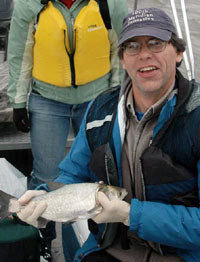
Scientists from the University of Notre Dame, Resources for the Future and the U.S. Forest Service presented their findings of the effectiveness of different Asian carp prevention barriers in a study published in the journal Environmental Science & Technology.
“Our study goes beyond just presenting barrier options by putting numbers to how effective various barriers will be, including hydrologic separation and the currently operating electric barrier system,” Marion Wittmann, the paper’s lead author and University of Notre Dame scientist, said.
The Notre Dame study used expert elicitation, a process of formalizing and quantifying experts’ judgments to estimate Asian carp barrier effectiveness. Federal agencies such as the U.S. EPA, NASA, U.S. Army Corps of Engineers and the U.S. Department of Transportation have successfully used similar expert elicitation in support of risk analysis and decision-making on issues ranging from food safety to radioactive waste management.
Experts estimated that hydrologic separation could prevent 95 percent to 100 percent of Asian carp from entering the Great Lakes, and an electric barrier could prevent between 85 percent and 95 percent of introductions. Experts were much less confident about using sounds, bubbles or strobe lights to deter the invasive fish and indicated that the failure rate could be between 80 percent to 100 percent for these methods, when used one at a time. However, using a combination of sounds, bubbles and strobe lights could prevent 75 percent to 95 percent of Asian carp from entering Lake Michigan.
The study uses a method of expert elicitation designed by co-author Roger Cooke, senior fellow with Resources for the Future. Cooke’s “Classical Method” weighs the opinion of each expert based on his or her knowledge and ability to judge relevant uncertainties.
“Our goal was to quantify uncertainty, not to remove it from the decision process,” Cooke said.
On Jan. 6, the U.S. Army Corps of Engineers submitted to Congress the Great Lakes and Mississippi River Interbasin Study Report, which outlined eight possible scenarios for preventing Asian carp passage through the Chicago area waterway system. The report provided no comparative evaluation of the options, but did indicate that developing infrastructure to keep Asian carp out of the Great Lakes could take decades and cost $15 billion or more.

“Protecting the Great Lakes from invasive species eventually comes down to understanding how effective a management strategy may be, how much it will cost and what the benefits of those options are,” David Lodge, director of the University of Notre Dame’s Environmental Change Initiative and co-author, said. “Here we have estimated the efficiencies of various barriers without having to wait for more barrier testing and while the fish are swimming closer to the Great Lakes.”
Environmental concerns are that if the Asian carp establish themselves in the Great Lakes, they will consume food sources of other fish, decimating local species.
“An important finding of this study is that knowledgeable experts identified clear differences in the likely effectiveness of some Asian carp prevention technologies as opposed to others,” John Rothlisberger, co-author on the paper and aquatic ecologist with the USDA Forest Service, said. “Physical separation stands out from the rest as having the least associated uncertainty and the highest probability of preventing the introduction of Asian carp into Lake Michigan.”
This study is part of a research award from NOAA National Centers for Coastal Ocean Science (NCCOS) to Lodge, with the University of Notre Dame Environmental Change Initiative, with funds provided to the NCCOS Center for Sponsored Coastal Ocean Research by USEPA Great Lakes Restoration Initiative.
Resources for the Future is an independent and nonpartisan institution devoted to research and publishing about critical issues in environmental and natural resource policy.
The U.S. Forest Service is dedicated to the conservation of natural resources, including water, fish and wildlife, for the benefit of the American people, the creation of jobs that sustain communities and the restoration and enhancement of natural landscapes.
Environmental Science & Technology is one of the world’s top sources of information for professionals in a wide range of environmental disciplines. Environmental Science & Technology publishes research articles, policy analyses, critical reviews, correspondences and corrections and is ranked No. 1 in total citations in the environmental engineering and environmental sciences categories as reported by the 2012 Journal Citation Reports (Thomson Reuters, 2013).
Contacts: Marion Wittmann, 574-631-2502, mwittma1@nd.edu; David Lodge, 574-631-6094, dlodge@nd.edu
Originally published by at news.nd.edu on January 29, 2014.